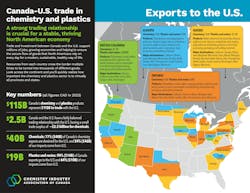While speaking with reporters on Feb. 2, U.S. President Donald Trump called trade with Canada a “one-way street.”
Leaders from the countries’ chemical industry trade groups beg to differ. They point to a pipeline of chemical products moving between the two nations. The United States sends about $32 billion ($46 billion CAD) worth of chemicals to Canada, according to the Chemistry Industry Association of Canada. This includes a significant amount of phenol used in Canada’s wood-products industry.
Meanwhile, the U.S. receives 77% of Canada's chemical exports, which amount to $28 billion (or $40 billion CAD).
Canada supplies the U.S. with plastics, resins and chemicals, including polyethylene, butyl rubber, chlorine and various pharmaceutical ingredients. About 60% of the chlorine used for chemicals to disinfect drinking water for the West Coast states comes from Canada, the American Chemistry Council (ACC) notes.
Many experts share the view that President Trump’s proposed tariffs — temporarily paused for Canada and Mexico — would significantly disrupt global supply chains as the two countries rank as the U.S. chemical industry’s top trade partners.
The tariffs, 25% for Canada and Mexico and an additional 10% for China, would raise costs for chemical producers and impact demand for downstream applications, such as automotive, construction, and food and beverage products, said Jeremy Leonard, managing director for global industry services at Oxford Economics.
“Upstream, tariffs on oil and petroleum products will have direct impacts on feedstock prices and increase input costs, which will harm competitiveness on the supply side,” he said. “As an example, Trump has implemented a 10% tariff on Canadian oil, so domestic chemical producers who use oil as an input will see cost increases.”
However, Leonard noted that since most U.S. chemical companies rely on domestic natural gas as their primary feedstock, many producers are likely to be insulated from these direct impacts. The more significant effects, he suggested, will be felt downstream, where demand will likely decline for Canadian-made products that use U.S.-produced chemicals.
An Integrated Chemical Market
Oxford Economics, a global economics advisory firm, conducted an analysis on how a hypothetical 25% tariff on European car exports to the United States would impact production. The Oxford Economics study shows German auto exports to the U.S. would drop 8% and total German auto production would decline 5%.
“We could expect similar impacts if such tariffs were imposed on Canada and Mexico, possibly larger, given the larger export dependence on the U.S.,” Leonard said. “This would have big impacts on chemicals demand in those countries. And since U.S. car production relies heavily on Canadian and Mexican inputs, U.S. car production is likely to fall as well.”
The Alliance for Chemical Distribution estimated that tariffs would lead to a total chemical price increase of $18 billion, potentially jeopardizing 5,000 industry jobs, shared Eric Byer, president and CEO of the organization, which represents about 400 chemical distribution providers.
“Furthermore, the uncertainty that businesses are navigating around these decisions make importing and distributing chemical products particularly challenging,” Byer said in an email to Chemical Processing. “Pair this with existing inflationary pressures, and businesses will have no choice but to pass additional costs onto consumers.”
Byer says his organization is encouraging the Trump administration to consider these downstream effects and work with the nation’s trading partners to strengthen the supply chain and economy.
Although the ACC refrained from directly criticizing the administration's tariffs, the trade group emphasized the urgent need for a resolution to prevent adverse effects on the chemical sector.
“The American chemical industry imports materials, many of which are unavailable in the United States, adding value and supporting other manufacturing supply chains domestically and abroad, through our exports,” the ACC noted in a press release.
The organization noted that the chemical industry is a net exporter, with a trade surplus of nearly $30 billion in 2023.
The View from Up North
Greg Moffatt, president and CEO of the Chemistry Industry Association of Canada, said it’s concerning when nations use tariffs to address non-trade-related issues. The Trump administration cited the high volume of fentanyl and illegal immigrants crossing the U.S. border as the primary reasons for imposing tariffs on Canada and Mexico.
“Many of the companies that you see in Canada are part of global multinationals, but certainly U.S.-based companies as well, so there’s a high degree of integration,” said Moffatt in a phone call from Washington, D.C., where he was attending an ACC board meeting. “They’re very, very concerned about North American trade and the uncertainty that's being created around the potential for significant tariffs influencing business decisions.”
One of the largest chemical industry projects under construction in Canada is Dow’s Path2Zero ethylene cracker in Fort Saskatchewan, Alberta. The $6.5 billion project, which includes an integrated ethylene cracker and derivatives facility in Alberta, will become the world's first ethylene cracker to achieve net-zero Scope 1 and 2 emissions using hydrogen as fuel, according to Dow.
When completed, Dow expects the facility to increase the site’s polyethylene capacity by 2 million MTA. Dow did not respond to a request for comment on the potential impact that tariffs could have on the project and related production goals. While Moffatt wouldn’t comment directly on the Dow project, he said tariffs could impact planning for some similarly large initiatives.
“If you haven't made a decision yet and you haven't broken ground, this causes you to pause and think about the business environment that you thought this facility would be coming into,” he said.
Supply Chain Disruptions: No Quick Fix
Also, the supply chains between the countries are so intertwined that it could take years to reconstruct them, Moffatt noted. He used chlorine production as an example. British Columbia and Quebec produce much of the chlorine used in the Northwest and Northeast regions of the United States because chlorine manufacturing in the U.S. is not located near those markets.
“There are cost implications. You can't really pivot super quickly to construct a chlorine manufacturing facility to meet U.S. needs,” Moffat explained. “So that's one specific example. And there are others, right? In Canada, we're producing polyethylene, polypropylene rubbers, sulfuric acid, hydrochloric acid, hydrogen peroxide. There’s just a broad spectrum of goods that are manufactured here, and they're sold into the U.S. market, and they're key contributors in the value chain.”
Moffatt added that it would take years to build that capacity in the United States to satisfy domestic demand.
Some manufacturers may try to divert trade to countries not covered by the tariffs, Leonard suggested, noting that during Trump’s first term, many companies switched to other low-cost countries like Vietnam instead of China.
“But in the case of chemicals, the U.S. has some structural advantages, such as lower feedstock costs than, for instance, Europe, so we will probably see some reshoring, more so than for other industries,” Leonard noted.
Some chemical producers may look to establish business in foreign-trade zones, leverage first-sale valuation or evaluate existing transfer-pricing agreements to mitigate the impact of tariffs, said Kit Johnson, director of trade compliance for John and James Co., an international freight forwarding and customs brokerage firm.
Supply chain restructuring is another consideration for chemical manufacturers but achieving that often requires a considerable amount of time and financial planning, Johnson cautioned.
“Some companies did that when it became evident the original China 301 tariffs weren't going away, but those companies that shifted production to countries like Mexico are now facing another shock,” Johnson said.




